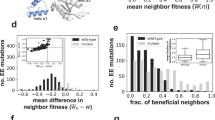Abstract
To make an evolutionary system highly evolvable, the genotype space of a protein must be occupied by a number of functional proteins. In addition, these proteins have to be interconnected, so that a mutation may be able to create another functional protein and explore the genotype space. The genotype space of a fixed-length protein is mathematically analyzed to formulate this condition quantitatively. A graph whose node represents a set of adjacent genotypes mapped to the same phenotype, and whose edge represents a mutational transition between a pair of nodes, is introduced. We then apply the random graph theory to this graph, and formulate the minimum density of functional proteins for high connectivity of the graph. The minimum density is approximately the reciprocal of the product of the average number of adjacent genotypes mapped to the same phenotype and the number of different genotypes created from one genotype through a unit mutational step. The formula derived is tested using data for a fictional two-dimensional protein model.
Similar content being viewed by others
References
Maynard-Smith J (1970) Natural selection and the concept of a protein space. Nature, London 225: 563–564
Lipman DJ, Wilbur WJ (1991) Modelling neutral and selective evolution of protein folding. Proc R Soc London B 245:7–11
Lau FL, Dill KA (1989) A lattice statistical mechanics model of the conformational and sequence spaces of proteins. Macromolecules 22:3986–3997
Lau FL, Dill KA (1990) Theory for protein mutability and biogenesis. Proc Natl Acad Sci USA 87:638–642
Bollobás B (1985) Random graphs. Academic Press, London
Palmer EM (1985) Graphical evolution. Wiley, New York
Reidys C, Stadler PF, Schuster P (1997) Genetic properties of combinatory maps: neutral networks of RNA secondary structures. Bull Math Biol 59:339–397, or Santa Fe Working Paper #95-07-058 available at http://www.santafe.edu/sfi/publications/ working-papers.html
Reidys C, Kopp S, Schuster P (1997) Evolutionary optimization of biopolymers and sequence structure maps. In: Langton C, Shimohara K (eds) Artificial life. V. Proceedings of the 5th International Conference on Artificial Life. MIT Press, Cambridge, p 379–386
Reidys C (1997) Random induced subgraphs of generalizedn-cubes Adv Appl Math 19:360–377
Schuster P (1997) Landscapes and molecular evolution Physica D 107:351–365, or Santa Fe Working Paper #96-07-047 available at http://www.santafe.edu/sfi/publications/working-papers.html
Reidys C, Forst CV, Schtister P (2001) Replication and mutation on neutral networks. Bull Math Biol 63:57–94, or Santa Fe Working Paper #98-04-036 available at http://www.santafe.edu/sfi/publications/working-papers.html
Hofacker IL, Fontana W, Stadler PF, et al. (1994) Fast folding and comparison of RNA secondary structures. Monatsh Chem 125:167–188
Nishikawa K (1993) Island hypothesis: protein distribution in the sequence space. Viva Origino 21:91–102
Suzuki H, Ray TS (2000) Conditions to facilitate the evolvability of digital proteins. JCIS (5th Joint Conference on Information Sciences, Proceedings. Vol. I. Association for Intelligent Machinery Inc., Durham, p 1078–1082
Author information
Authors and Affiliations
Corresponding author
About this article
Cite this article
Suzuki, H. Minimum density of functional proteins to make a system evolvable. Artif Life Robotics 5, 93–96 (2001). https://doi.org/10.1007/BF02481345
Received:
Accepted:
Issue Date:
DOI: https://doi.org/10.1007/BF02481345




